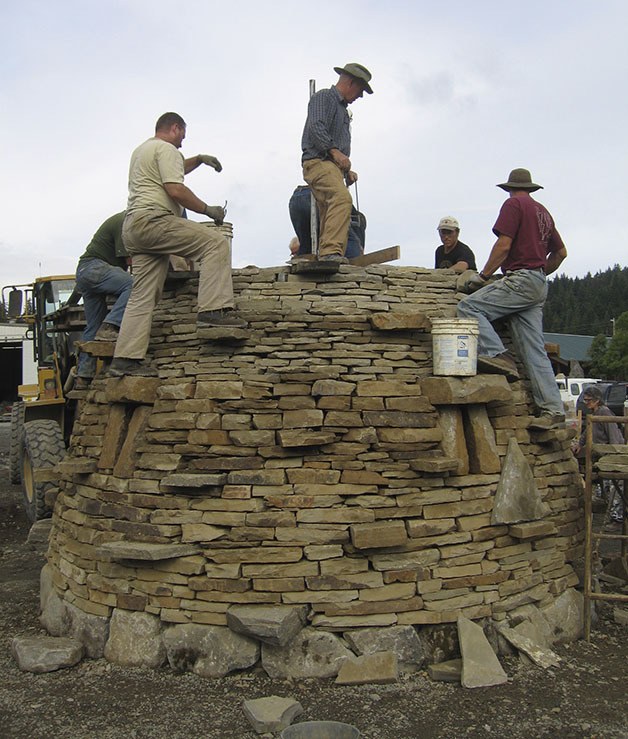It takes a lot of people and a lot of focus to build a stone church in just five days.
OK, the church may be in miniature—the sanctuary can fit perhaps one small visitor—but it’s still real local granite, done much the way its models were built in Ireland 1,000 years ago.
“We laugh about it being a church for a congregation of one,” said Alexandra Morosco, founding co-director of StoneFest, the instructional seminar hosted by Preston’s Marenakos Rock Center for the past decade. “But the design will be true to a style seen in that period.”
Ten years ago, Morosco founded StoneFest with co-director and Marenakos owner Scott Hackney as a way to bring stoneworkers together. StoneFest annually brings between 75 and 125 craftspeople and enthusiasts to Preston.
For the 10th anniversary, May 12 to 16, the festival brings leaders from many different organizations—non-profits, educational communities and clubs from Scotland, Ireland, Canada and the United States—all linked to stone. It’s a summit of stoneworkers from many walks of life—builders, carvers, landscapers and instructors in the trade.
The festival “is for anyone who works with stone or has a passion for stone,” Morosco said. “They might be customers who say, ‘I just love putting rocks in my garden. I want to handle them (better). A lot are in the trade and do this professionally.”
For a week, visitors work and share knowledge. One night, there’s a Stone FEAST, in which workers (hopefully) drop their tools for a moment and enjoy food, drink and entertainment together on the grounds at Marenako’s. The cost for a full week is $495, but scholarships or daily passes are available for those on a budget.
Passing on knowledge
Today, stone is thought of as a green material. There’s less processing and handling of stone than other building materials.
But stone isn’t used as widely as it was hundreds of years ago.
“There was a time when lots of people were in the stone trade,” said Morosco. “It was a given that you would work for years as an apprentice before you learned your trade.”
Today, the skills aren’t as prevalent, and they aren’t always something you can learn on YouTube or through books. Stone skills must be handed on in-person before they disappear forever. StoneFest’s mentor and apprenticeship programs help that happen.
Some of the older stoneworkers, men in their 90s, “are amazing, Morosco said. “They know things no one knows about. If we lose these guys before they share the knowledge, it goes with them.”
“These are people that work with their hands and learn with their hands,” she said. “That’s why this is hands-on.”
So, through classroom time, design workshops, and hard work with bare hands and tools, skills are renewed.
“We hope the real results are when they go back home to work,” Morosco said. “If nothing gets built at this event, what’s important is that they learn.
The two major projects happening at this year’s StoneFest include both the miniature church and a castle rampart, to be built up between six and ten feet high.
The festival requires up to 70 tons of stone. Stone blocks fetch between $300 to $600 a ton, so it’s a sizeable investment from the festival’s sponsors. All the visitors, the projects and activity show off that stone to strong effect.
“It does put Marenako’s on the map (as) one of the most extraordinary stoneyards in the country,” said Morosco.
Some of the best StoneFest creations become permanent attractions, such as the 2010 clochan, or monk’s stone cell, or the portrait arch. Stone craftspeople can come back with clients and show them their finished projects anytime.
Besides construction, another big aspect of the festival is carving. There is an emphasis on hand tools, but power tools are allowed for those who work harder stone
Some of the craftspeople at StoneFest work on their own projects, and end up bringing their worked block of stone home with them. Others put their effort into a group project—a carved portrait arch from a past StoneFest permanently memorializes that team task.
“We connect people to stone,” Morosco said. “We also connect people to people. StoneFest creates a network that helps people gather knowledge and experience, so they have the confidence to do work.”
“We’ve always had a connection to stone,” she said. “We’ve had this long, deep resonance…. That’s why we walk on a beach and pick up pebbles.”
The festival helps make stone more user-friendly for beginners, and deepens experts’ relationship with this age-old material.
“By being around it, and sharing ideas, it brings people the confidence to work with stone,” Morosco said.
StoneFest seminars
StoneFest shares skill and knowledge of the stone trade. Visitors work as a community for five intense days. This year’s projects include:
• Elements of Sacred Space: An Early Irish Church: Visitors build a small-scale church
• Every Man’s Home is His Castle: Participants build a scaled down castle rampart with dry stone talus, small towers or turrets and a pyramid spur. This will be an advanced project involving setting out geometry and merging shapes to challenge the experienced mason.
• Richard Rhodes, of Rhodesworks Design Studio and Rhodes Architectural Stone will be offering two workshops, a Design Charrette and Presentation workshop
To learn more, visit stonefest.org/stonefest2014/stonefest-2014-catalog/.

Volunteer students at the annual StoneFest stoneworking seminar at Preston built this replica of an ancient Irish clochan, or beehive shelter.

At a past StoneFest, Nicholas Fairplay demonstrates carving on a memorial a participant designed for her beloved lost pets.


